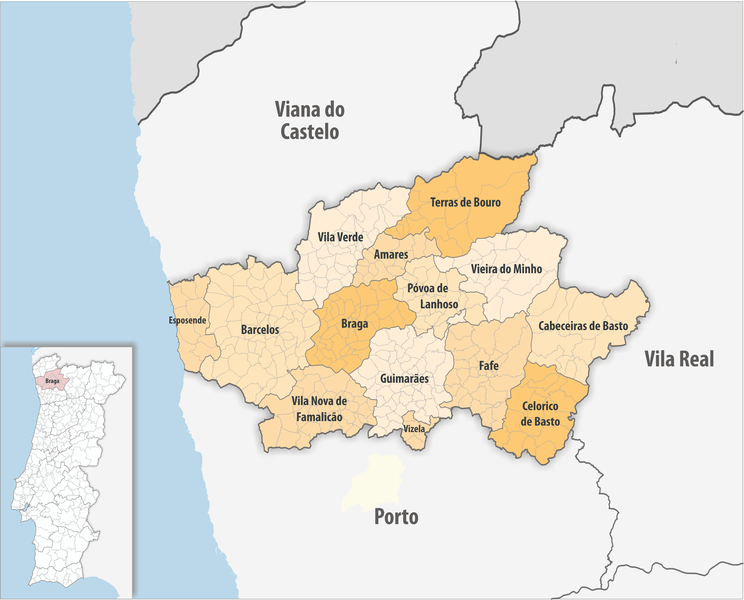|
Roriz (Barcelos)
Roriz is a Portuguese ''freguesia'' ("civil parish"), located in the municipality of Barcelos in the district of Braga. The population in 2011 was 2,152, in an area of 6.53 km2. History The parish was first mentioned in a census organized by D. Pedro, bishop of Braga, between 1085 and 1091, where it was referenced as "De Sancto Micahel de Rooriz". There are subsequent mentions of this parish in the Royal Portuguese commissions of 1220 and 1258. A richer historical depiction of the parish can be found in the Parochial Memories of 1758 The Parochial Memories of 1758 ( pt, Memórias Paroquiais de 1758) are the results of an enquiry sent to every parish in Portugal following the 1755 Lisbon earthquake, by order of Sebastião de Carvalho e Melo, the Secretary of State of Internal ..., which mention the importance of the agricultural practice as sustenance for its residents. The most abundant crops are reported to have been corn, millet, beans and rye, with a mention of win ... [...More Info...] [...Related Items...] OR: [Wikipedia] [Google] [Baidu] |
Cávado (intermunicipal Community)
The Comunidade Intermunicipal do Cávado () is an administrative division in northern Portugal. It was created in 2008. It is also a NUTS3 subregion of the Norte Region. The seat of the intermunicipal community is Braga, Norte. Cávado comprises part of the former Braga District. The population in 2011 was 410,169, in an area of , which makes it one of the most densely populated subregions of Portugal. Currently, as of 2021, it has 416.679 inhabitants and a population density of 351 per square kilometres. Its name is derived from the Cávado River that drains a large part of its territory. It borders the intermunicipal community of Ave and the Metropolitan Area of Porto to the south, Alto Tâmega to the east, Alto Minho to the north and the Atlantic Ocean The Atlantic Ocean is the second-largest of the world's five oceans, with an area of about . It covers approximately 20% of Earth's surface and about 29% of its water surface area. It is known to separate the " Old Worl ... [...More Info...] [...Related Items...] OR: [Wikipedia] [Google] [Baidu] |
Braga District
The district of Braga ( pt, Distrito de Braga ) is a district in the northwest of Portugal. The district capital is the city of Braga, and it is bordered by the district of Viana do Castelo in the north, Vila Real in the east, Spain ( Galicia) in the northeast and Porto in the south. Its area is and it has a population of 831,368. Municipalities The district comprises 14 municipalities: * Amares * Barcelos * Braga * Cabeceiras de Basto * Celorico de Basto * Esposende * Fafe * Guimarães * Póvoa de Lanhoso * Terras de Bouro * Vieira do Minho * Vila Nova de Famalicão * Vila Verde * Vizela Geography The district of Braga has a very rugged terrain, dominated by high altitudes to the east, close to the Spanish border and the border with the Vila Real district, and going down towards the western coast, cutting through the valleys of several rivers that flow from the north-east to the south-west. The highest altitudes are found in the Serra Amarela (1,361m), on the border wi ... [...More Info...] [...Related Items...] OR: [Wikipedia] [Google] [Baidu] |
Barcelos, Portugal
Barcelos () is a city and a municipality in Braga District in the Minho Province, in the north of Portugal. The population in 2011 was 120,391, in an area of 378.90 km2. With 60 parishes, it is the municipality with the highest number of parishes in the country. It is one of the growing municipalities in the country, and is well known by its textile and adobe industries, as well as its horseback riding events and "figurado" style of pottery, which are comical figurines with accentuated features of farmers, folk musicians, and nativity scene characters. Barcelos is part of the UNESCO Creative Cities Network as a Crafts and Folk Art City. History Originally a Roman settlement, it expanded and became the seat of the First Duke of Bragança in the 15th century. The palace of the Dukes of Bragança was destroyed by an earthquake in 1755 and is now an open-air museum. The town is on the Portuguese Way, a Christian pilgrimage route connecting the Camino de Santiago. Constru ... [...More Info...] [...Related Items...] OR: [Wikipedia] [Google] [Baidu] |
Barcelos 412 , a title of nobility in Portugal
{{disambiguation, geo, surname ...
Barcelos may refer to: * Barcelos, Amazonas a municipality in the state of Amazonas * Barcelos, Portugal, a municipality in the district of Braga ** Barcelos (parish), a former-civil parish in the municipality of Barcelos People with the name * Pêro de Barcelos, Portuguese explorer of North America See also * Barceló * Count of Barcelos Count of Barcelos (in Portuguese ''Conde de Barcelos'') is a title of nobility, the first to be granted in Portugal. It was created in 1298 by king Denis I and initially it was a non hereditary title, although most of the holders belonged to the ... [...More Info...] [...Related Items...] OR: [Wikipedia] [Google] [Baidu] |
Portugal
Portugal, officially the Portuguese Republic ( pt, República Portuguesa, links=yes ), is a country whose mainland is located on the Iberian Peninsula of Southwestern Europe, and whose territory also includes the Atlantic archipelagos of the Azores and Madeira. It features the westernmost point in continental Europe, and its Iberian portion is bordered to the west and south by the Atlantic Ocean and to the north and east by Spain, the sole country to have a land border with Portugal. Its two archipelagos form two autonomous regions with their own regional governments. Lisbon is the capital and largest city by population. Portugal is the oldest continuously existing nation state on the Iberian Peninsula and one of the oldest in Europe, its territory having been continuously settled, invaded and fought over since prehistoric times. It was inhabited by pre-Celtic and Celtic peoples who had contact with Phoenicians and Ancient Greek traders, it was ruled by the Ro ... [...More Info...] [...Related Items...] OR: [Wikipedia] [Google] [Baidu] |
Freguesia
''Freguesia'' (), usually translated as "parish" or "civil parish", is the third-level administrative subdivision of Portugal, as defined by the 1976 Constitution. It is also the designation for local government jurisdictions in the former Portuguese overseas territories of Cape Verde and Macau (until 2001). In the past, was also an administrative division of the other Portuguese overseas territories. The ''parroquia'' in the Spanish autonomous communities of Galicia and Asturias is similar to a ''freguesia''. A ''freguesia'' is a subdivision of a ''município'' (municipality). Most often, a parish takes the name of its seat, which is usually the most important (or the single) human agglomeration within its area, which can be a neighbourhood or city district, a group of hamlets, a village, a town or an entire city. In cases where the seat is itself divided into more than one parish, each one takes the name of a landmark within its area or of the patron saint from the usually co ... [...More Info...] [...Related Items...] OR: [Wikipedia] [Google] [Baidu] |
Barcelos Municipality, Portugal
Barcelos () is a city and a municipality in Braga District in the Minho Province, in the north of Portugal. The population in 2011 was 120,391, in an area of 378.90 km2. With 60 parishes, it is the municipality with the highest number of parishes in the country. It is one of the growing municipalities in the country, and is well known by its textile and adobe industries, as well as its horseback riding events and "figurado" style of pottery, which are comical figurines with accentuated features of farmers, folk musicians, and nativity scene characters. Barcelos is part of the UNESCO Creative Cities Network as a Crafts and Folk Art City. History Originally a Roman settlement, it expanded and became the seat of the First Duke of Bragança in the 15th century. The palace of the Dukes of Bragança was destroyed by an earthquake in 1755 and is now an open-air museum. The town is on the Portuguese Way, a Christian pilgrimage route connecting the Camino de Santiago. Constru ... [...More Info...] [...Related Items...] OR: [Wikipedia] [Google] [Baidu] |
Inquirições
Inquirições were the Royal Portuguese commissions. They were put forward by the crown in accomplishing edicts. Afonso II of Portugal, Afonso II instituted (from 1220) inquirições to investigate the nature of holdings and to recover whatever had been illegally taken from the crown. This issue was in response to the church's rein over Portuguese land as they supported Afonso's fight in the civil war with Sancho II of Portugal, Sancho II. The General Inquirições The general ''Inquirições'' were issued by King Afonso III of Portugal, Afonso III in 1258 to investigate the nature of holdings and to recover whatever had been illegally taken from the crown. The royal commissions were met with much protest by the prelates as it would have deprived the church of much property. Most of the prelates subsequently left the country. Although Afonso was excommunicated and threatened with deposition, he continued to defy the church until shortly before his death early in 1279. Eventua ... [...More Info...] [...Related Items...] OR: [Wikipedia] [Google] [Baidu] |
Parochial Memories Of 1758
The Parochial Memories of 1758 ( pt, Memórias Paroquiais de 1758) are the results of an enquiry sent to every parish in Portugal following the 1755 Lisbon earthquake, by order of Sebastião de Carvalho e Melo, the Secretary of State of Internal Affairs of the Kingdom. The exercise was organised according to a plan containing sixty written questions; the compiled answers, relaying accounts on not only the damage sustained by the earthquake but also information on the local geography, demography, history, and economy, are valuable historical documents and are stored in the country's National Archive. Because Secretary Carvalho e Melo (today more commonly known by the title of Marquis of Pombal Count of Oeiras () was a Portuguese title of nobility created by a royal decree, dated July 15, 1759, by King Joseph I of Portugal, and granted to Sebastião José de Carvalho e Melo, head of the Portuguese government. Later, through another roy ...) was the first to attempt an objectiv ... [...More Info...] [...Related Items...] OR: [Wikipedia] [Google] [Baidu] |


